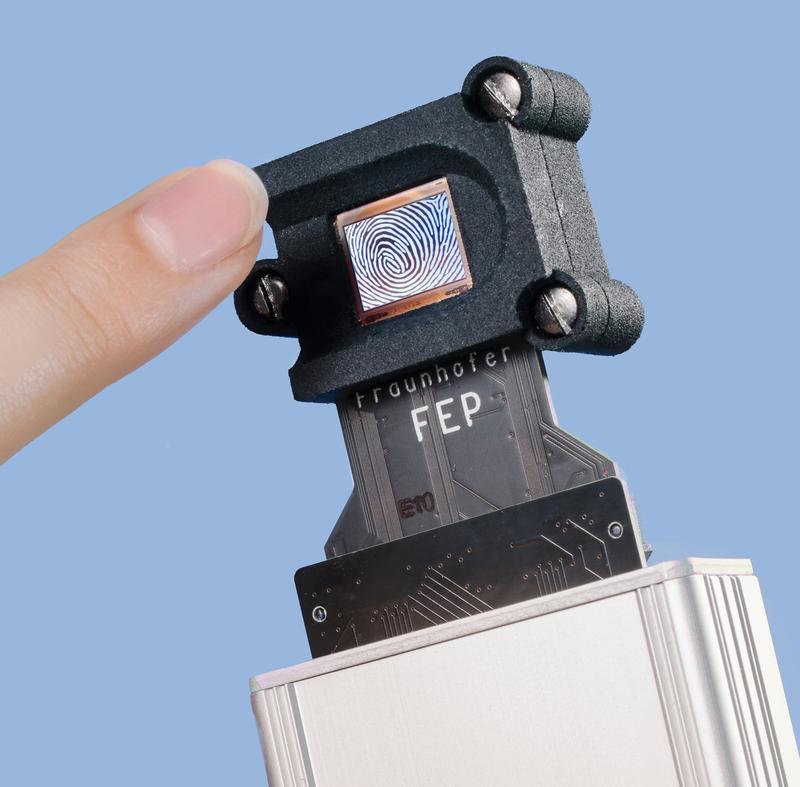
BiClean – Smart antibacterial surfaces using bidirectional display technology

Fingerprint sensors based on bidirectional display technology
© Fraunhofer FEP; Picture in printable resolution: www.fep.fraunhofer.de/press
You can find them everywhere – at the shower curtain, in pipes or at the tap. Biofilms can form on almost any surface, as long as the supply of moisture is sufficient. The word biofilm describes an accumulation of microorganisms, mostly bacteria, which live in close community within a mucous substance.
Since biofilms are very persistent, they represent a hitherto unsolved problem in many areas of daily life. Especially in medicine there is a high risk of infection due to the growth of biofilms on implants and catheters. In fact, pathogens in over 60% of infectious diseases cannot be effectively treated because they are protected by the biofilm.
The biofilm has many advantages for the bacteria: they are protected against antimicrobial substances such as antibiotics and disinfectants and are much more resistant to mechanical influences.
Typical examples are fingerprint sensors – regular tools for e.g. entry or access controls or in personal smartphones for authentication – whose surface is touched continuously and thousand fold by fingers. On the touch surface, biofilm growth is supported by perspiration and other microbial secretions. The risk of germ transmission from user to user is extremely high.
To date, there is no method with which biofilms can be effectively prevented or specifically inactivated. Within the framework of an internal funding project, the Fraunhofer FEP worked on a novel approach for the automated detection and inactivation of biofilms.
The project „BiClean“uses fingerprint sensors as an example, offering an innovative technical tool for the detection and removal of biofilms and thus preventing the risk of the transmission of pathogenic germs. Bidirectional displays have been coated with titanium dioxide (TiO2) or TiO2-containing layer combinations, thus the biofilm can be inactivated.
Bidirectional displays can emit light or content as well as detect and evaluate the incoming light via an integrated camera function. The development of this display technology is one of the core competencies of the Fraunhofer FEP. The bidirectional characteristic allows the recording of the surface status by the device itself.
This makes it possible to detect the formation of biofilms and then start a cleaning interval depending on the degree of contamination. Another research focus is the cleaning of the surface, which will also be done by light emission from the display. This is where another core competence of the Fraunhofer FEP comes into play: coating technologies for easy-to-clean surfaces.
“The idea of fighting biofilm is based on two steps,” explains Dr. Gaby Gotzmann, Group Manager Disinfection, Sterilization and Biofunctionalization, “In the first step, the surface contamination is analyzed by means of a detector function. If a surface contamination is -identified, secondly a customized chemical reaction is triggered on the surface by light emission, whereby biofilms can be inactivated.”
The fields of application of this idea are manifold- from the effective cleaning of solar and photovoltaic systems to the cleaning of drinking water pipes and fluid-carrying systems to the removal of biofilms on catheters and in vivo infection detection and treatment on implants, there is a far-ranging market potential.
Fraunhofer FEP at parts2clean 2019:
October 22 – 24, 2019
Stuttgart, Germany
Exhibition:
Joint booth of Fraunhofer „Allianz Reinigung“: Hall 9, booth no. C31
Expert forum and talks:
October 22, 2019
10:00 – 12:00 am; expert forum
Session “Cleaning processes“; Moderator: Frank-Holm Rögner, Fraunhofer FEP
12:00 am
„Überwachung der Umgebungsbedingungen zum Schutz empfindlicher gereinigter
Bauteile“, Frank-Holm Rögner, Fraunhofer FEP
October 23, 2019
3:00 pm
„Smarte Oberflächenanalyse mittels bidirektionaler Displaytechnologie“,
Dr. Gaby Gotzmann, Fraunhofer FEP
Poster
at „Fachverband industrielle Teilereinigung (FiT)“ booth, QSREIN4.0; hall 7, booth C02
Press contact:
Ms. Annett Arnold
Fraunhofer Institute for Organic Electronics, Electron Beam and Plasma Technology FEP
Phone +49 351 2586 333 | presse@fep.fraunhofer.de
Winterbergstraße 28 | 01277 Dresden | Germany | www.fep.fraunhofer.de
https://www.fep.fraunhofer.de/en/press_media/15_2019.html












